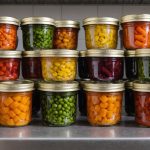When it comes to preparing meals in your kitchen, ensuring food safety and hygiene is paramount. Not only does it protect your health, but it also preserves the integrity of the food you consume. Emphasizing principles like cleanliness, proper cooking methods, and safe storage can make a significant difference in preventing foodborne illnesses. This article explores essential steps you should take to maintain food safety and hygiene in your kitchen.
Understanding the Importance of Food Hygiene
Food hygiene is foundational to keeping your meals safe. In your kitchen, bacteria thrive on surfaces like countertops, cutting boards, and utensils if they aren’t properly cleaned. We cannot stress enough the importance of understanding how these microorganisms can contaminate your food and cause illness. By committing to rigorous cleanliness, you can significantly reduce these risks.
Topic to read : How do you effectively gather and analyze customer feedback in a restaurant setting?
The Role of Hygiene in Preventing Bacterial Growth
- Bacteria multiply rapidly in warm environments. Therefore, maintaining a clean kitchen is vital. Regularly wash surfaces that come into contact with raw foods, especially meat and poultry.
- Hands are a critical source of contamination. You should wash them thoroughly with warm water and soap before and after handling food.
- Use separate cutting boards for raw and cooked foods. Cross-contamination is one of the most common ways bacteria spread in the kitchen.
Cleaning Routines for Optimal Kitchen Hygiene
- Clean surfaces with hot, soapy water before and after food preparation.
- Disinfect sinks and counter areas regularly to inhibit bacterial growth.
- Change dish towels frequently. A damp towel can harbor millions of germs.
By understanding the importance of food hygiene and adopting these practices, you can ensure a safer kitchen environment.
The Critical Role of Cooking Temperatures
Cooking food to the right temperature is a pivotal step in ensuring it is safe to eat. This section explores why monitoring cooking temperatures is indispensable in your kitchen.
Topic to read : How can you optimize your menu for food delivery services in the UK?
Why Temperature Matters
Cooking food to the proper temperature kills most pathogenic bacteria that can cause illness. For instance, undercooked poultry might harbor harmful bacteria like salmonella. It’s crucial to use a food thermometer to check the internal temperature of your dishes.
Recommended Cooking Temperatures
- Poultry should be cooked to an internal temperature of at least 165°F (74°C).
- Ground beef, lamb, and pork should reach a temperature of 160°F (71°C).
- Fresh beef, veal, lamb, and pork chops should be cooked to at least 145°F (63°C) with a resting period.
Cooking Methods to Prevent Foodborne Illness
- Use a food thermometer in the thickest part of the meat to ensure it has reached the safe temperature.
- Avoid partial cooking to prevent bacteria from surviving. Ensure all parts of the food are evenly cooked.
- Reheat leftovers to a consistent 165°F (74°C) to ensure all potential bacteria are killed.
Understanding and applying these cooking principles can be instrumental in keeping your family safe from foodborne illnesses.
Safe Storage Practices
Proper food storage is another crucial aspect of maintaining food safety. Foods can easily become contaminated if not stored correctly, leading to spoilage and the growth of harmful bacteria.
Storage Guidelines for Safety
- Cold Storage: Refrigerate perishable foods promptly. Your refrigerator should be kept at 40°F (4°C) or below, and your freezer at 0°F (-18°C) or below.
- Separation: Keep raw foods separate from cooked foods to prevent cross-contamination.
- Containers: Store food in airtight containers to prevent exposure to air and potential contaminants.
Understanding Shelf Life
- Labeling: Clearly label and date all stored food items to keep track of their freshness.
- FIFO Principle: Follow the “First In, First Out” method. Use older food items before reaching for newer ones.
- Temperature Zones: Be aware of danger zones. Bacteria thrive between 40°F (4°C) and 140°F (60°C), so ensure food spends minimal time in this range.
By adhering to these storage practices, you can maintain the quality and safety of the food in your kitchen.
Proper Handling of Raw Foods
Handling raw foods correctly is essential in preventing contamination and ensuring food safety. This section guides you through the best practices for managing raw ingredients such as meat and poultry.
Handling Tips for Raw Ingredients
- Washing: Contrary to popular belief, washing raw poultry is not recommended as it can spread bacteria around your kitchen. Instead, pat it dry with paper towels.
- Separation: Always use separate equipment for raw and cooked items, including cutting boards and utensils.
- Temperature: Ensure raw meat is kept at a cool temperature until it is cooked to minimize bacterial growth.
Cross-Contamination Prevention
- Avoid Rinsing Raw Meat: Rinsing can splash bacteria onto other kitchen surfaces.
- Dedicated Tools: Have dedicated tools like knives and chopping boards for raw foods only.
- Cook Immediately: Try to cook raw items soon after preparation to limit bacterial proliferation.
Hygiene Practices during Preparation
- Clean Hands: Continuously wash your hands when handling different food items to prevent the spread of bacteria.
- Surface Sanitation: Clean all surfaces with disinfectant after preparing raw foods.
Adopting these practices can significantly reduce the risk of foodborne diseases and ensure that your kitchen remains a safe place for meal preparation.
Food safety and hygiene are vital in any kitchen. By understanding and implementing the practices outlined in this article, you can effectively protect yourself and your loved ones from foodborne illnesses. Remember to maintain strict cleanliness, cook foods to the correct temperature, store them safely, and handle raw foods with care. These steps are integral to keeping the food in your kitchen safe and enjoyable. By embracing these measures, you ensure that your kitchen remains a place of health and well-being.











